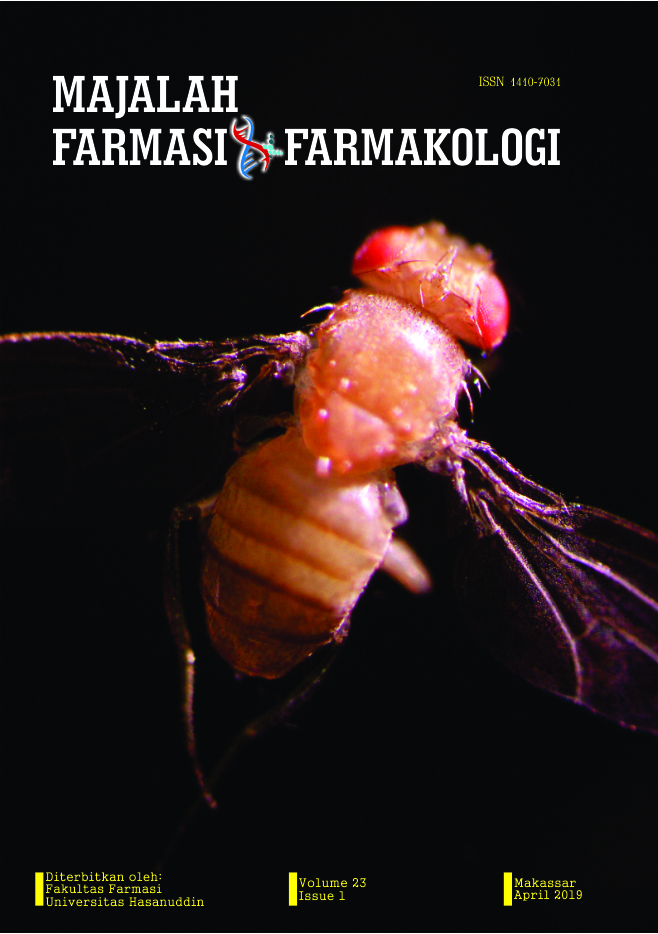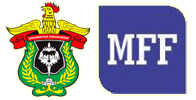PENGUJIAN EKSTRAK KELUWAK TERHADAP AKTIVITAS REPRODUKSI DENGAN MODEL Drosophila melanogaster
Abstract
Keluwak merupakan hasil fermentasi secara alami dari biji Pangi (Pangium edule Reinw) yang mengandung senyawa yang bersifat sebagai antioksidan. Senyawa antioksidan dapat mempengaruhi kondisi penuaan sel dalam tubuh dengan cara menangkal radikal bebas penyebab stress oksidatif. Penelitian bertujuan untuk mengetahui efek ekstrak keluwak terhadap aktivitas reproduksi Drosophila melanogaster. Dalam penelitian ini digunakan lalat jantan dan lalat betina yang diberi pakan normal (kontrol sehat), ekstrak keluwak 1,25% dan vitamin C selama 15 hari. Selanjutnya, jumlah total pupa dan jumlah lalat dewasa yang berhasil berkembang dari pupa dihitung setiap tiga hari. Hasil penelitian menunjukkan bahwa ekstrak keluwak 1,25 % dan vitamin C dapat meningkatkan jumlah pupa dan anak dibandingkan dengan kontrol sehat. Dengan demikian dapat disimpulkan bahwa ekstrak etanol keluwak dapat meningkatkan aktivitas reproduksi Drosophila melanogasterReferences
Susiarti S, (2015). Pengetahuan dan pemanfaatan tumbuhan obat masyarakat lokal di Pulau Seram, Maluku bidang botani, Pusat Penelitian Biologi, Lembaga Ilmu Pengetahuan Indonesia .Bogor.
Orhan I E, (2014), Pharmacognosy: Science of natural products in drug discovery, Bioimpacts, 4(3):109–110.
Rashrash M, Schommer J C, Brown L M, (2017), Prevalence and predictors of herbal medicine use among adults in the United States, Journal of Patient Experience, 4(3):108–113.
Young I S, Woodside J V, (2001), Antioxidants in health and disease, Journal of Clinical Pathology, 54:176–186
Andarwulan N, Fardiaz S, Apriyantono A, Hariyadi P, Shetty, K, (1999), Mobilization of primary metabolites and phenolics during natural fermentation in seeds of Pangium edule Reinw, Process Biochemistry, 35, 197–204.
Anwar E, (1992), Isolasi antioksidan dari biji picung (Pangium edule Reinw) terfermentasi, IPB. Bogor.
Santoso M, Yamaguchi T, Matoba T, Takamura H, (2014), Effects of pit fermentation and thermal cooking process on the antioxidant activity and components of Pangium edule seeds, 4(4):202–213.
Dua D, Srivastava N S, (2016), A study on antioxidant and anti-aging properties of few medicinal plants, International Journal of Pharmacy and Pharmaceutical Sciences. 8(1):344–347.
Omelyanchuk L V, Shaposhnikov M V, Moskalev, A A, (2015), Drosophila nervous system as a target of aging and anti-aging interventions, Frontiers in Genetics. 6(89):1–5.
Jafari, M, (2010), Drosophilla melanogaster as a model system for the evaluation of anti-aging compounds, Fly, 4(3):253-257.
Illiadi K G, Boullianne G L, (2010), Age related behavioral changes in Drosophila, Ann N. Y. Acad. Sci. 1197:9–18.
Austad S N, Fischer K E, (2016), Sex differences in lifespan, Cell metabolism, 23(6): 1022–1033.
Grotowiel M S, Martin I, Bhandari P, Cook-Wiens E, (2005), Funtional senescence in Drosophila melanogaster, Aging Research Reviews, 4(3):372–397.
Mangunwardoto W, Ismaini L, Heruwati E S, (2008), Analisis senyawa bio aktif dari ekstrak biji Picung (Pangium edule Reinw) segar, Berita Biologi, 9(3):259-264.
Departemen Kesehatan Repulik Indonesia, (2008), Farmakope Herbal Indonesia Edisi I. Direktorat Jenderal Bina Kefarmasian dan Alat Kesehatan.
Sun, Y, Yolitz J, Wang C, Spangler E, Zhan M, Zhou S, (2013), Aging studies in Drosophila melanogaster. Methods Mol Biol, 1048: 77-93.
Bahadoroni S, Bahadoroni P, Philips J P, Hiliker A J, (2008), The effect of vitamin suplementation on Drosophila life span under normoxia and under oxidative stress, The Journals of Gerontology Series A, 63(1): 35-42.
Chattopaddhyay D, Chitnis A, Talekar A, Mulay P, Makkar M, James J, Thirummugaa K, (2017), Hormetic efficacy of rutin to promote longevity in Drosophila melanogaster. Biogerontology, 18(3):397–411
Panchal K, Tiwari A K, (2017), Drosophila melanogaster “a potential model organism” for identification of pharmacological properties of plants/ plant-derived components. Biomedicine & Pharmacotherapy, 89:1331–1345.
Downloads
Published
Issue
Section
License
The copyright to this article is transferred to Universitas Hasanuddin (UNHAS) if and when the article is accepted for publication. The undersigned hereby transfers all rights in and to the paper including without limitation all copyrights to UNHAS. The undersigned hereby represents and warrants that the paper is original and that he/she is the author of the paper, except for material that is clearly identified as to its original source, with permission notices from the copyright owners where required. The undersigned represents that he/she has the power and authority to make and execute this assignment.
We declare that:
- This paper has not been published in the same form elsewhere.
- It will not be submitted anywhere else for publication prior to acceptance/rejection by this Journal.
- A copyright permission is obtained for materials published elsewhere and which require this permission for reproduction.
Furthermore, I/We hereby transfer the unlimited rights of publication of the above-mentioned paper in whole to UNHAS The copyright transfer covers the exclusive right to reproduce and distribute the article, including reprints, translations, photographic reproductions, microform, electronic form (offline, online) or any other reproductions of similar nature.
The corresponding author signs for and accepts responsibility for releasing this material on behalf of any and all co-authors. This agreement is to be signed by at least one of the authors who have obtained the assent of the co-author(s) where applicable. After submission of this agreement signed by the corresponding author, changes of authorship or in the order of the authors listed will not be accepted.


